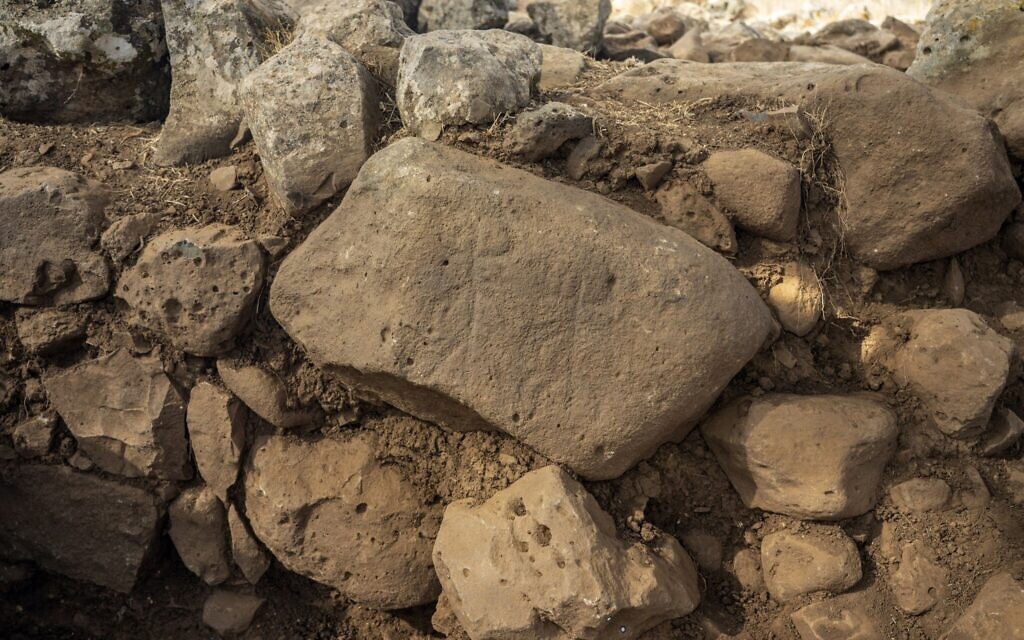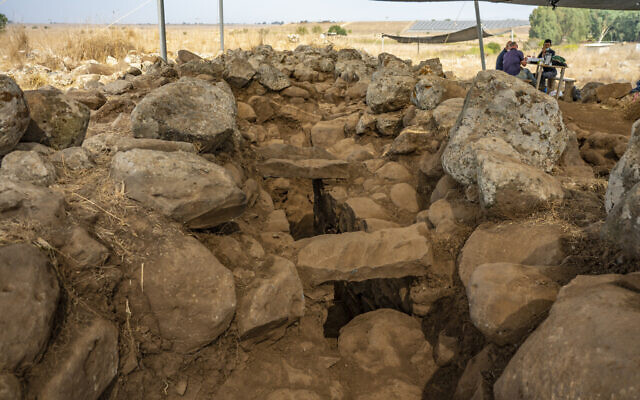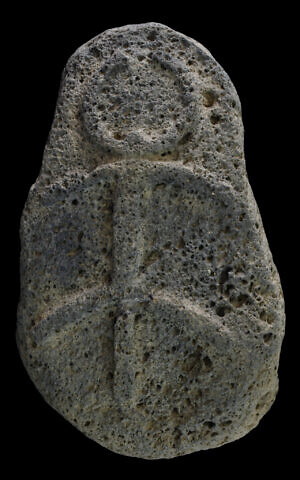
Posted on 11/12/2020 7:48:35 AM PST by SJackson
Stunning stone etching of two horned individuals at prayer found at mouth of rare circa-11th century citadel in Israel’s north; could predate famous Geshur site, Tel Bethsaida

Dating to around the time of King David 3,000 years ago, what may be the earliest fortified settlement in the Golan Heights was recently discovered during salvage excavations ahead of the construction of a new neighborhood. Incredible rock etchings of two figures holding their arms aloft — possibly at prayer with what could be a moon — were uncovered inside the unique fort, which was dated to circa 11th-9th century BCE.
The striking find is being tentatively linked to the Geshurite people, whose capital is recorded in the Bible as having been located nearby, to the north of the Sea of Galilee.
In a brief Hebrew video about the discovery, dig co-director Barak Tzin said that when the etching was found near the entrance of the fort, “We understood that we had something very, very important… We were astonished to discover a rare and exciting find: a large basalt stone with a schematic engraving of two horned figures with outspread arms.”
Next to the etching was discovered a stone table or shelf, which the archaeologists believe was an altar, upon which was found another seemingly ritual object of a small figure holding what looks to be a drum.
Just which people manned the fort — built of large basalt boulders with almost 1.5 meter wide walls — is still an open question, IAA’s scientific adviser in the northern region Ron Be’eri told The Times of Israel on Wednesday.

“The minute that Egyptian and Hittite empires are destroyed… there is a big vacuum. There is no historian that writes the history of the era and we return to a sort-of ‘pre-history’ in which we only have physical artifacts to base our assumptions upon. So we go into the realm of speculation. It is impossible to know what really happened,” said Be’eri.
The small fort was built on a hilltop that would have served as a lookout at a strategic river-crossing location above the El-Al River canyon. Be’eri said the fort itself is evidence of the era of conflict and struggle for control that began after the fall of the northern Hittite empire in circa 1180 BCE.
Be’eri told The Times of Israel that his dating of the site to circa 11th-9th century BCE was made based on physical evidence, mostly the plentiful pottery sherds, which point to the early Iron Age, and are somewhat comparable with those found at Israelite sites such as Tel Megiddo that are dated to circa 11th-10th centuries BCE.
“The ability to identify the pottery is limited, we don’t have many comparisons,” Be’eri cautioned.
This is an era of “foggy history” as small city-states attempted to fill the vacuum created by the splintering of the Hittite empire in the north and the Egyptian empire in the south.
Among the peoples fighting for a foothold were the Geshurites, a group of Arameans, whose capital city was in today’s Bethsaida, just north of the Sea of Galilee.
It is possible, said Be’eri, that the Haspin (also known as Hispin) fort belonged to the Geshurite people, or another Aramean group. There is scant physical evidence of these peoples during this era, and no outside textual documentation other than various citations in the Hebrew Bible.
“The problem is, the biblical text is not a historical document, rather theological, and was written by lines of kings who had their own agenda,” said Be’eri. “Therefore we must rely on physical artifacts.”
While the Israelite artifacts of the era are well known, there are many fewer remains left by the Aramean peoples. The closest comparisons to the cultural evidence of the fort are found at the Tel Bethsaida archaeological site.
 >
>
The cultic stele from Bethsaida discovered in the Bethsaida Excavation Project in 2019. (Ivgeni Ostrovski, Israel Antiquities Authority) In 2019, a very similar-looking stone etching of a horned figure with outstretched arms and what appears to be a moon was discovered at Tel Bethsaida by archaeologist Rami Arav of Nebraska University. The stele likewise was erected next to a raised platform (bama) near the impressive city gate.
Geshur is noted in the Bible through the politically motivated marriage of Geshur King Talmai’s daughter Maachah to King David. The 10th century BCE Bethsaida thereafter allied itself with King David and his dynasty, the House of David.
One noteworthy mention of Geshur in the Bible is as a place of refuge to King David and Maachah’s son, Absalom, after the murder of his half-brother Amnon to avenge the rape of his sister Tamar. In 2 Samuel 15:8, the prince speaks to his father, King David, saying, “For I vowed a vow while residing in Geshur, which is in Aram, saying, ‘If the Lord will bring me back to Jerusalem, then I will worship the Lord.'”
Other known Geshur cities are found along the Sea of Galilee shore, including Tel En Gev, Tel Hadar and Tel Sorag, but in the Golan such sites are hardly known, according to the IAA press release.
The sole potential “evidence” for the historical veracity for King David — the Tel Dan Stele, which was written after 870 BCE and mentions a triumph over the “House of David” — was discovered at another Aramean settlement in the kingdom of Aram in northern Israel.
The Tel Dan stele mentions, ‘House of David.’ It was discovered by Avraham Biran in 1993. (courtesy Prof. Yosef Garfinkel) Until now, very few sites have been found in the Golan. Be’eri carefully proposes that the new fort, which he is calling “Nov-Haspin” after the two adjacent settlements, is a bit earlier than the well-dated Bethsaida site.
“This is my impression, but we are very early in the research and have no clear conclusions yet,” said Be’eri.
What is clear, he said, is the site’s importance as a “national treasure” that must be conserved. According to the IAA press release, the Housing and Construction Ministry and the IAA are already busy planning an open-air archaeology site that can be enjoyed by visitors.

“In modern Israel and in the Golan in particular we are blessed with a lot of development and construction — often at the expense of the archaeological sites. This site is a national treasure and the IAA is going to do everything it can to make sure it is not hit, too,” said Be’eri.
..................
ping
PinGGG!..............
What wonderful news! Imagine: The Bible, coming to life!
‘Face
:o]
Very interesting! David’s troubles with Saul paled in comparison to his troubles of marrying multiple wives for the sake of political expediency and wealth inheritance.
The Old Testament was NOT written by kings with their own agenda. Good grief. It was written by prophets and Moses.
My goodness, the books of Chronicles and Kong’s are full of information that showed the downfalls of Israelite Kong’s and their kingdoms. If anything, these books serve as warnings to future leaders.
Unlike other ancient civilizations where the kings are “like gods,” and those historical relics and reliefs are full of boasting and small portions of accuracy, The Bible paints no ideal is picture of the kings and details their flaws.
Should say Kings.
Thanks
:) AMEN! Use the Bible as a map and in context. Watch out for the Garden though, it’s well guarded.
I grew up near Trenton on the pennsy side and loved going to Washington’s Crossing to walk where Washington and his troops were. I believe a couple of trees are that old too.
So being able to walk in Israel or where the city of the Great King will reign bringing true peace on earth would be inexplicable.
Disclaimer: Opinions posted on Free Republic are those of the individual posters and do not necessarily represent the opinion of Free Republic or its management. All materials posted herein are protected by copyright law and the exemption for fair use of copyrighted works.